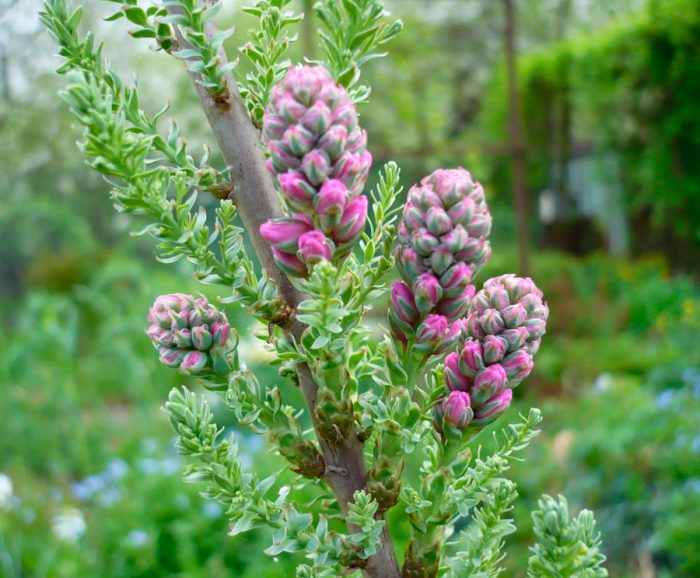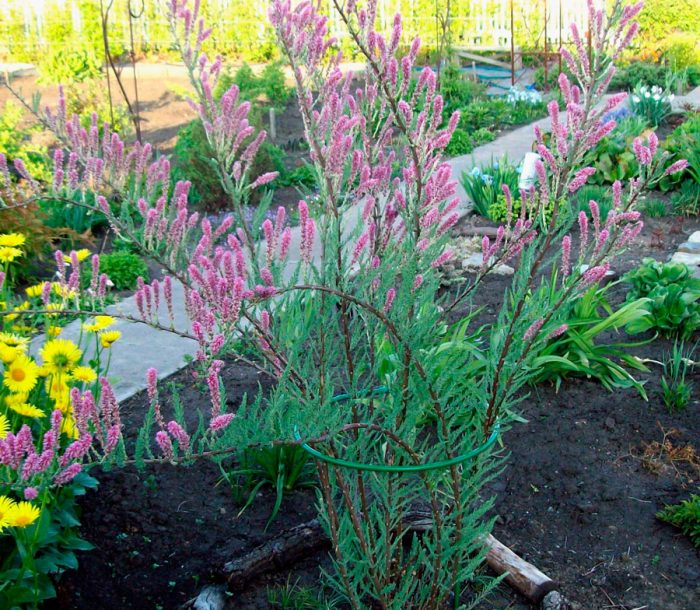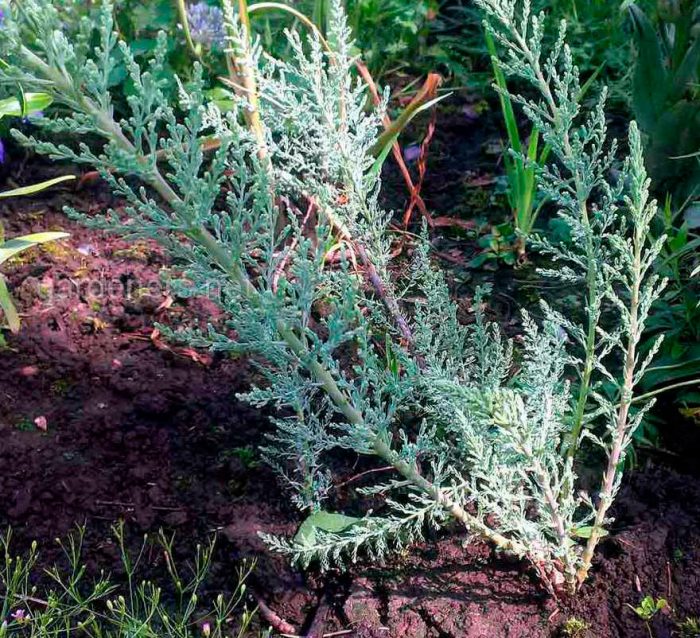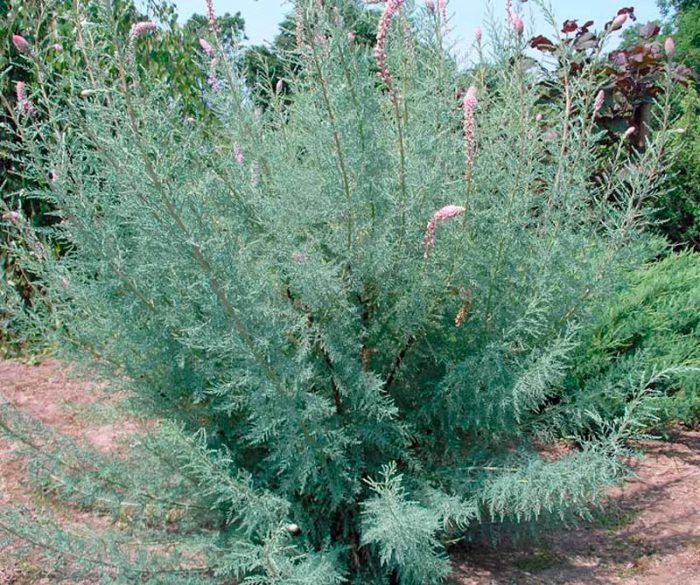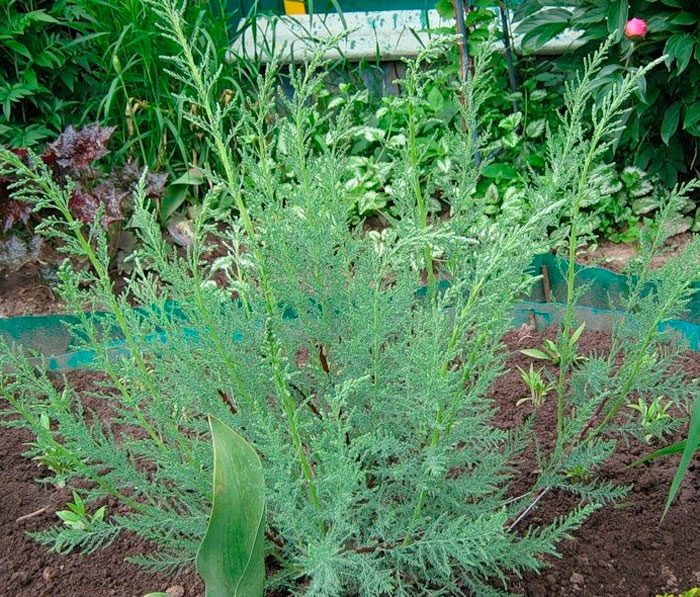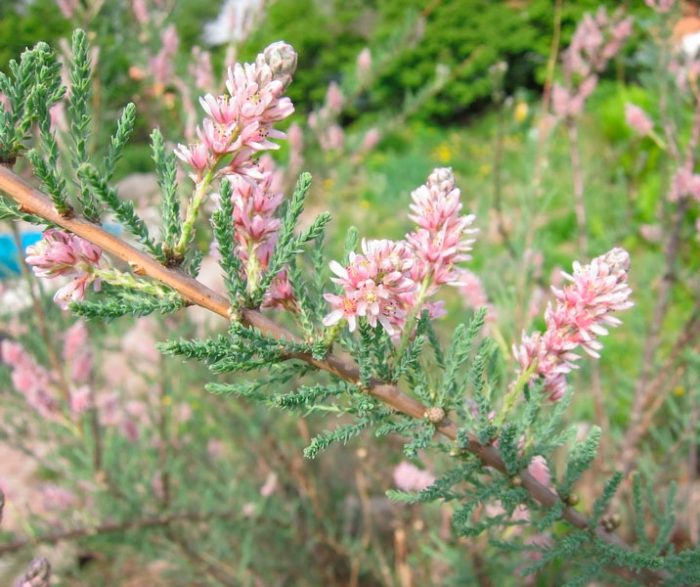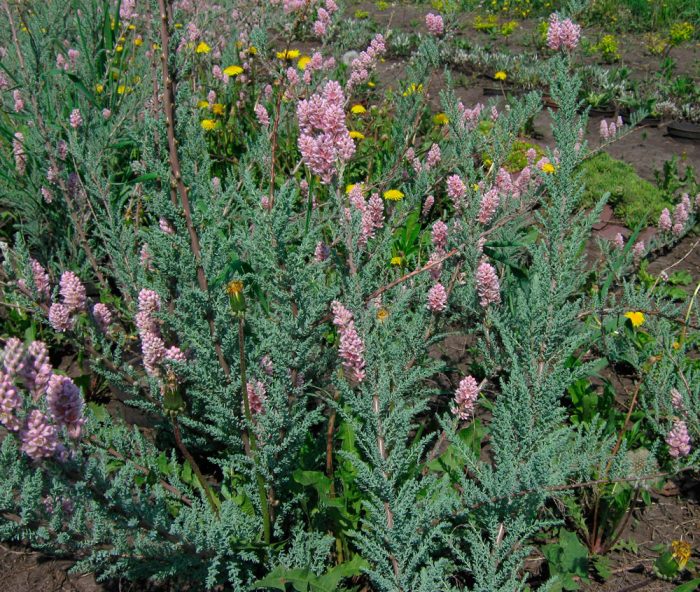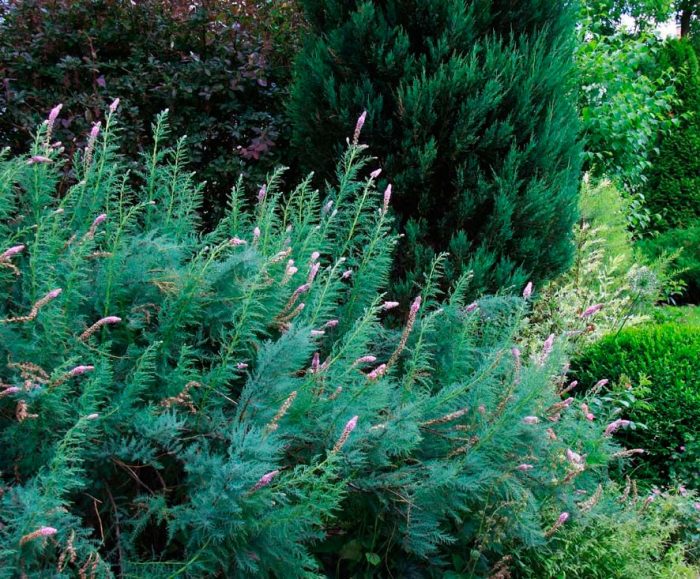The myrikaria shrub is relatively popular with gardeners for its unusual foliage. It differs from most horticultural crops in that the main decoration of its dense, spectacular bushes are scaly branches of a silvery color.
Content
Features of myrikaria
Mirikaria is a perennial that is part of the Grebenshchikov family. Outwardly, this plant is similar to heather. The name of this genus is a word form of the Latin name for heathers "mirica".
In nature, this plant can be found in Asia: from Altai to Tibet. It was most widespread on the plains of Mongolia and China. It can also often be found on heights and plateaus at an altitude of up to 1900 meters above sea level.
The branching shoots of this shrub are colored brown-yellow or pale red, and are decorated with very small leaf plates, which are scales. In temperate climates, the height of low spreading bushes can reach 100–150 cm. However, sometimes there are wild specimens, the height of which is about four meters. In diameter, the shrub can reach about one and a half meters.
Each shrub has 10 to 20 main ascending woody stems with a smooth surface. The surface of the short lateral shoots is covered with small fleshy leaf plates, which are colored greenish-blue.
The growing season of myrikaria begins in May and ends with the first frost. During the entire period of active growth, the shrub has an attractive appearance.
The bush blooms for eight weeks, and the opening of delicate buds is observed in mid-May. It blooms for so long, because its flowers do not bloom all at once, but gradually. The first to open are the buds on the lower branches. By the end of flowering, the opening of the buds occurs on the top of the bush. The lifespan of each individual flower is 3-5 days. The flowers are collected in inflorescences, spike-shaped, which rise on a long (about 0.4 m) peduncle. Flowers can form in the axils of the leaves and in the upper part of the shoots (depending on the variety). The inflorescences consist of many small flowers of lilac or violet color, which are tightly pressed against each other.
When the shrub has faded, elongated pyramidal seed pods form in place of the flowers.The seeds are very small, and their surface is covered with pubescence of a whitish shade.
Reproduction methods
Growing from seeds
It is necessary to store myrikaria seeds correctly, otherwise they will very quickly lose their germination. They are stored for storage in a waterproof bag, which must be hermetically closed. The air temperature should be moderate.
Sowing of seed is carried out the next year after collection. It needs stratification. When 7 days remain before sowing the seeds, they are placed on the shelf of the refrigerator for this time, and the temperature should be from 3 to 5 degrees. Stratified seeds are distinguished by high germination rate - more than 95 percent. If we neglect the preparation of seeds, then at best only 1/3 of it will sprout.
Fill the seed box with the substrate and spread the seeds over the surface. From above, the seeds are not sprinkled with earth, and also they are not buried in the substrate. It is recommended to irrigate crops using the ascending or drip method. The seeds will hatch after two or three days, while the first seedlings will appear only after about 7 days. When the seedlings grow up and get stronger, they are planted in open ground. This is done only after warm weather sets in, because even small frosts are detrimental to plants.
Cuttings
Carry out the preparation of cuttings. For this, you can use both lignified stems and young (annual). It is possible to propagate myrikaria cuttings throughout the growing season. The length of the segments should be 0.25 m, and their thickness can be up to 10 mm.
After cutting, the cuttings are immersed in a solution of a growth stimulating agent, for example: Heteroauxin, Epin or Kornevin. You need to get them out after 1-3 hours and immediately plant them in cut plastic bottles or separate pots. Despite the fact that the cuttings give roots quickly, the plants are kept at home during the first year. The point is that they will not be able to survive the cold winter. With the onset of spring, when it gets warmer outside, you can plant cuttings in open ground.
Myricaria care
The myricaria plant is very resistant to both pests and diseases. It is also distinguished by its unpretentiousness. It is not harmed by both high (up to 40 degrees) and very low (up to minus 40 degrees) air temperature.
It grows well in an area with nutritious garden soil, or on peat loamy soil. The ground should be slightly acidic or neutral.
Watering
This drought-resistant plant is watered only during dry periods, and even then infrequently. However, on wet soil, the growth of the bush increases and it blooms more magnificently. On average, during a drought, it is watered twice a month, with one bucket of water per plant. Stagnation of liquid in the ground, as well as short-term flooding of the soil, does not harm myricaria.
Top dressing
If every year you cover the surface of the trunk circle with a layer of humus or peat, then the color of foliage and flowers becomes brighter. During the growing season, the plant can be fed once or twice. A universal heather fertilizer is suitable for this.
Lighting
The shrub grows best in light shade. But it can also be grown in sunny areas. However, the scorching rays of the sun in the afternoon can leave burns on young shoots.
Pruning
Over time, lignification of the plant occurs. When he turns 7 or 8 years old, his decorative effect is significantly reduced. However, systematic pruning of the bush will help prevent this. It is carried out in 2 stages:
- in the autumn - formative;
- in spring - sanitary (dried and frozen shoots are removed).
Garter
Strong gusts of wind can damage the spreading stems. In this regard, the myrikaria needs a special shelter, or for its planting they choose areas protected from the wind. In late autumn, a bush is tied to a support.This is necessary so that the plant can withstand strong winds and snow drifts. In this case, young stems are recommended to be bent to the soil surface and fixed in this position.
Types of myrikaria
Gardeners cultivate only 2 types of myrikaria: foxtail and daurian.
Mirikaria Daurian, or long-leaved
The most widespread species is in Altai and in the southern part of Siberia. In young shoots, during the first year of growth, the bark is colored green with a yellowish tinge. Over time, its color changes to brown. The length of narrow leaves is from 0.5 to 1 centimeter, and their width is from 0.1 to 0.3 centimeters. They are painted in a gray shade, and their shape can be ovoid or oblong. The top of each leaf plate is covered with small glands.
Peduncles are formed on one-year-old apical and adult lateral stems. Inflorescences can be simple or complex (branched). Initially, the peduncles grow shorter, but by the beginning of flowering they noticeably lengthen. In diameter, the bracts reaches about 0.6 cm, and a small calyx is formed on it, measuring 0.3 to 0.4 cm. The oblong pink petals protrude forward by 0.5-0.6 cm, while they reach about 0.2 cm. The capitate stigma of the ovary is decorated with stamens, which have grown together in half. Elongated tricuspid seed pods are formed on the bush. Inside them are small seeds 0.12 cm long, and their awn is partially pubescent.
Myrikaria foxtail, or foxtail
In nature, it is most often found in Central Asia, the Far East and Western Europe. Lateral stems of low bushes are ascending and straight. They are covered with a multitude of alternately scaly fleshy leaf plates, which are colored in a bluish-silvery hue.
From the second half of May to the last days of August, the tops of the shoots are decorated with racemose inflorescences of pink color. The inflorescences are lush, and the lower buds bloom first. The inflorescences are very heavy, so the stems often lean towards the ground, taking on an arched shape. Before the flowers begin to bloom, the peduncle is about 10 centimeters long and outwardly similar to a dense bump. But over time, its length increases to 0.3–0.4 m, and it itself becomes less dense.
Fruits begin to ripen in September. The seeds are located on the tops of the branches and have a whitish pubescence. As a result, the long stems look very similar to a fox's tail with a fluffy whitish tip. This is what influenced the choice of the name of this species.
Mirikaria in landscape design
Mirikaria is perfect for decorating artificial and natural reservoirs. It is grown both singly and in group plantings. The shrub looks best next to coniferous and deciduous crops of a dark green color. It is also often planted in a rose garden.

